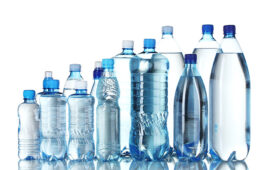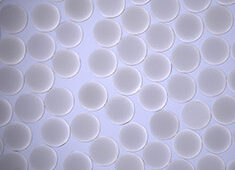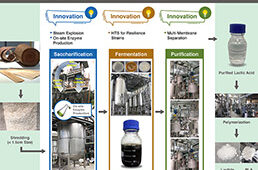Friction by region: When two microscopic surfaces with the same structure slide over one another, not all particles move at the same time. In fact, the particles in some areas slide (blue spheres), thus distorting their configuration. The other particles (green) stay where they are in the hollows of the surface. Image: Thomas Bohlein/Ingrid Schofron |
The
problem exists on both a large and a small scale, and it even bothered
the ancient Egyptians. However, although physicists have long had a good
understanding of friction in things like stone blocks being pulled by
workers into the shape of a pyramid, they have only now been able to
explain friction in microscopic dimensions in any degree of detail.
Researchers from the University of Stuttgart and the Stuttgart-based Max
Planck Institute for Intelligent Systems arranged an elaborate
experiment in which they pulled a layer of regularly ordered plastic
spheres over an artificial crystal made of light. This enabled them to
observe in detail how the layer of spheres slid over the light crystal.
Contrary to what one might imagine, the spheres do not all move in
unison. In fact, it’s only ever some of them that move, while the others
stay where they are. This observation confirms theoretical predictions
and also explains why friction between microscopic surfaces depends on
their atomic structure.
Friction
causes the economy enormous losses—but without friction, absolutely
nothing would work: the cost of machine parts rubbing against each other
as a result of wear, for instance, is estimated to amount to around
eight per cent of the German GDP—some 200 billion euros. And that does
not even take into account the fact that tectonic plates rubbing
together is what causes earthquakes. If a car’s tyres or the soles of
your shoes did not grip the ground, neither wheels nor feet would be
able to move forward. The dominant factors in these examples of friction
between large objects have been well understood by physicists for some
time now; the countless small irregularities that all surfaces exhibit
are instrumental here. They are what lie behind the fact that two large
surfaces only touch each other at certain points.
The
situation is quite different when two microscopically small surfaces
rub against each other. Providing they have been accurately produced,
they touch each other with all the atoms of their surface. The
researchers from Stuttgart have now observed for the first time how
friction takes place on this atomic level. Their experiment also enables
them to understand why surfaces with the same structure create more
friction when they rub against each other than those with differing
structures.
“In
this way, we are creating the basis for the construction of micro- and
nano-machines that are as low in friction as possible,” says Clemens
Bechinger, Professor at the University of Stuttgart and Fellow at the
Max Planck Institute for Intelligent Systems.
Distortions of the surface create movements
Using
laser light and electrically charged plastic spheres in a water bath,
his team created a 2D model of two surfaces rubbing against each other.
As the spheres suspended in the water repel each other electrically,
they arrange themselves in a periodically ordered layer. They form a
surface. The scientists create the other surface below the layer of
spheres using intensive laser beams. They overlap the electromagnetic
waves from the beams one above the other so that a light crystal, a type
of optical egg carton, is formed.
“Using
a surface created by light has enabled us to observe the processes that
take place on rubbing surfaces directly with a camera—for the very
first time,” says Thomas Bohlein, who conducted the experiment as part
of his doctoral studies. “That’s not possible in experiments with
three-dimensional objects, because the boundary layer is not visible.”
Bohlein
started by precisely calibrating the distance between the hollows in
the optical egg carton against the distance between the plastic spheres.
One might think that the surfaces would jerkily separate and then snap
back into place, one on top of the other, just like two egg cartons
would do if you tried to pull one over the other.
But
what the experiment showed was a totally different mechanism. When the
team drew the plastic spheres across the optical surface, not all of the
spheres began to slide simultaneously. In fact, some of the particles
moved only within certain areas. In these areas, the spheres left their
comfortable hollows and also moved slightly closer together. This
phenomenon is possible because the spheres, and also the atoms in a
surface, do not sit next to each other immovably—they always have a
little room to maneuver. And the distortions in the layer of spheres or
atoms that occur when they are pulled mean that they do not quite fit
back into the surface of the optical crystal. This makes it much easier
to pull the particles out of their hollows.
Friction is much reduced in surfaces with different structures
As
the researchers pull the particle layer, the compressed zones move
through the layer of spheres, with only the particles in these zones
able to get out of their hollows.
“For
the overall layer, it is more efficient to let a distortion zone move
through the layer successively rather than to move all of the spheres
from one hollow to the next simultaneously,” says Bechinger.
The
compressed areas that migrated towards the pulling force over the
optical surface became ever larger as the team pulled the layer of
plastic spheres more strongly.
In
the next experiment, the Stuttgart-based physicists pushed the hollows
in the optical egg carton slightly closer together so that they did not
correspond well with the alignment of the plastic spheres from the
start. “As a result, fewer particles find a space in a hollow, and the
distortion zones move over the surface much more easily,” says Bohlein.
Physicists had already suspected that local distortions—which they call kinks and antikinks—played the crucial role in the friction between microscopic surfaces.
“We
have observed these changes in the surface experimentally for the first
time,” says Bechinger. “As such, we have confirmed the theoretical
predictions about the way friction works in atomic dimensions.”
Surfaces without friction will be thinkable
However,
the scientists in Stuttgart went one step further. Physicists had
hardly any idea what happened in terms of friction between a crystalline
surface and a quasi-crystalline surface. Quasicrystals, for whose
discovery Shechtman received the Nobel Prize in Chemistry this year,
exhibit small areas with a strict order. But this is not repeated
regularly in larger dimensions, like in a real crystal.
Bohlein
formed a quasicrystal beneath the crystalline layer of plastic spheres
by again skilfully superimposing the laser beams. The plastic spheres
came to rest in the hollows of the quasicrystalline surface only at rare
intervals, and the friction was drastically reduced compared with that
of two crystalline surfaces.
“Our
experiment provides the proof that one of the reasons why friction on
quasicrystalline surfaces is so low is because the structures are
incommensurate,” says Bohlein.
The
discovery of how friction works on a micro-scale could also have
practical consequences. “Above all, the combination of a crystalline and
a quasicrystalline surface offers the possibility to reduce the
friction in micro- and nano-systems,” says Bechinger. “But it is also
conceivable to design surfaces that slide over one another with
virtually no friction.”





